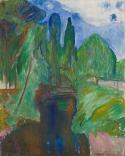Art Of The Day Weekly
#473 - from 18 May 2017 to 24 May 2017
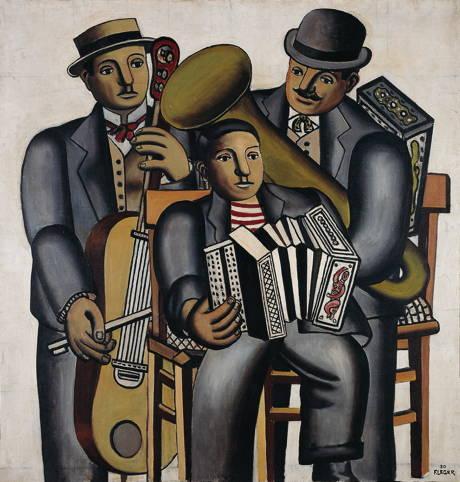
Fernand Léger, The Three Musicians, 1930, oil on canvas, 118 x 113.5 cm © Von der Heydt-Museum Wuppertal / Photo: Medienzentrum, Antje Zeis-Loi © Adagp, Paris, 2017 (exhibition at Centre Pompidou Metz).
FIVE MAJOR ARTISTS FROM THE 20TH CENTURY
The Biennale of Venice presents us with the best works of contemporary production, rewarding new talents and confirmed artists. Simultaneously, five major European museums seem to have agreed to present five of their elders who have left their print on XX century art. This distance taken by these institutions in. Regard to the artists gives us a wider perspective. Munch, whose work was adored and bought by the Norwegian National Gallery when he was barely thirty years old, could never have imagined that half a century later he would be labeled a degenerate in Germany, a country of great culture, and have his paintings thrown out with the trash. Giacometti, on the other hand, interested no one when he was thirty or a little older, except for Michel Leiris and Georges Bataille who published a review of his work in 1929 in Documents. Could he have imagined that some of his sculptures are worth over €100 million today? The avant-garde is a very movable and relative concept and success is something of a two-way road at times.
FRANCE
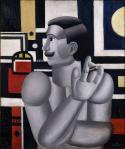
Fernand Léger, The Mechanic, 1918. Oil on canvas, 65 x 54 cm, Centre Pompidou, MNAM-CCI, on loan to LaM, Lille Métropole musée d'art moderne d'art contemporain et d'art brut, Villeneuve d'Ascq © Photo Philip Bernard © Adagp, Paris 2017.
The power of Léger
METZ – His work does not correspond to his name. “Fernand Light”, as we read in certain translations, was actually Fernand Léger (1881-1955). His art is full of muscle, of color, and of mechanics which some derided as “tubist”. We could actually describe him with four “c” s: cubist, communist, city dweller (a native from Normandy- Argentan- who loved Paris and settled there at age 19 in 1900, the same years as Picasso), and cinema lover (with the Ballet mécanique, his first movie without a script). This retrospective endeavors to demonstrate the different facets of an art that believed in progress, which we seem to have somewhat lost. As the Centre Pompidou celebrates its 40th birthday it is understandable that many but not all of the works come from Paris. There are a few classics, such as The Builders from the musée Fernand Léger in Biot, The Three Musicians from Wuppertal, or The Typographer from Philadelphia. In passing we will mention that Léger played a role in teaching others, through his academy where he received individuals as unexpected as Louise Bourgeois and photographer William Klein.
• Fernand Léger, le beau est partout (Beauty is everywhere) at the Centre Pompidou, from 20 May to 30 October 2017.
FRANCE
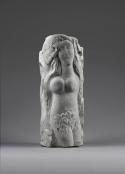
Marc Chagall, Two Nudes or Adam and Eve or Sculpture-column, 1953. Marble, 53x20x17 cm. Private Collection © Benoît Coignard.
Chagall the sculptor, a discovery
NICE – Picasso’s sculptures remained a well-guarded secret until his estate was settled and revealed the extent of the work. The case is quite similar as far as Chagall is concerned, but for another reason: no one was ever interested in it as the artist from Vitebsk seemed to perfectly express his colorful fantasy in his painted work. It is therefore a surprise to learn that Chagall sculpted during the last forty years of his long life (1887-1985) passionately. He sculpted ceramics at Madoura’s, like Picasso, and plaster. Up to there, all is fine. But when we realize that at age sixty he also decided to stand up to stone - marble or limestone from Rognes. The religious or animal themes he chose express a very powerful primitive sense, partly digested by the influence of Gauguin.
• Chagall, Sculptures at the Musée national Marc Chagall, from 27 May to 28 August 2017.
THE NETHERLANDS
Arp, a magician of forms
OTTERLO – His short and strong sounding name, of one single syllable, cracks like a flag in the wind. On the other hand, his surprisingly varied creations cannot be constrained by a definition. Some are round, others are full of spikes, they are sometimes simple like pebbles softened by the wind, and yet others are sometimes complicated like intellectual speculations, and full of humor. Whether with collages, reliefs, stabiles, or concretions, native Strasbourgeois artist Hans Arp (1886-1966), both a French and German citizen, went through the influence of Dada, of Surrealism, and of Abstraction-Creation. As befits an exhibition in this museum, one of the most beautiful in the Netherlands, in the middle of a park, his work is studied in its relations with the Stijl movement led by Mondrian and Van Doseburg, whose centennial is currently celebrated.
• Arp : The Poetry of Forms at the Kröller Muller Museum, from 20 May to 17 September 2017. The exhibition will move as of 12 October 2017 to the Turner Contemporary in Margate.
GREAT BRITAIN
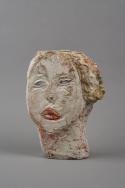
Alberto Giacometti, Head of Woman [Flora Mayo], 1926. Painted plaster, 31.2 x 23.2 x 8.4 cm. Collection Fondation Alberto et Annette Giacometti, Paris. © Alberto Giacometti Estate, ACS/DACS, 2017.
Giacometti, in search of the essence
LONDON – There is never a dull moment for Alberto Giacometti (1901-1966): that is the random for success. His dual with Picasso was hardly over at the musée Picasso in Paris on 5 February this year that he once again is in the limelight, but alone this time. The Tate Modern is dedicating a retrospective to his art that is meant to be exhaustive. It spans from the twenties –when he just arrived in Paris at the Académie de la Grande Chaumière, to study with Bourdelle -, including his Surrealist period with his Femme égorgée, continuing with his typical elongated figures that reached fame –and high figures – from the post-war period, partially inspired by his wife Annette, all the way to the painted portraits of his last passion, Caroline.
• Alberto Giacometti at the Tate Modern, from 10 May to 10 September 2017.
NORWAY
Munch, leaving appearances behind
OSLO - Edvard Munch (1863-1944) is undoubtedly the national Norwegian artist par excellence. He is world-known for his Scream which seems to summarize modern alienation. But throughout his long career he dealt with many other themes. As of 1885 he came to France often and for long stays, and as a matter of fact the first painting the Galerie nationale bought was Night in Nice. This retrospective owes its originality to its commissary, writer Karl Ove Knausgaard, born in 1968 and the author of My Struggle . He chose to present some one hundred paintings, some little known, in a sort of initiatory journey. The viewer enjoys peopled, sociable and charming scenes and slides progressively towards a savage, hostile and empty nature before ending with introspection, and internal landscapes, which Munch expresses in his many portraits.
• Towards the Forest, Knausgard on Munch at the Munch Museum, from 6 May to October 2017.
OPENINGS OF THE WEEK

ANDRE SUREDA
20 May 2017 - VERSAILLES - Musée Lambinet
A little-known painter from Versailles (1872-1930), in love with Northern Africa


